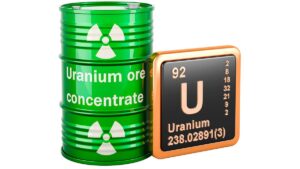Iron ore posts biggest single day fall… EVER. Where is it heading next?

Pic: Bloomberg Creative / Bloomberg Creative Photos via Getty Images
It powers Australia’s economic engine room, but iron ore is sputtering after the spot price recorded its biggest single day drop on Friday since index pricing began.
Fastmarkets saw iron ore prices for benchmark 62% fines to northern China drop a dramatic US$20.73 to $132.66.
The other major index the S&P Global Platts index had prices to a bit over US$130/t, both a drop of almost 15%.
As the bear market has swiftly taken hold on the back of both reported and actual Chinese Government restrictions on steel production, prices have fallen more than US$100/t from record highs of over US$230/t seen in mid-May.
The weekly fall of around 20% is the largest on record as well and for a bigger monthly drop you need to go back as far as 2008.
Record iron ore fall? Using daily & weekly data for 62% #ironore indices to 2009, yesterday was largest daily fall on record (-13%), and as it currently stands, largest weekly fall (-20.6%). However, on monthly data to 2005, still only 3rd largest (mtd -28%). Oct 2008 saw -42%! pic.twitter.com/ZOvZMsZ17a
— Robert Rennie (@Robert__Rennie) August 20, 2021
Australian producers avoided a major sell-off but the Pilbara majors are all down double digits this week after soaring to record highs in late July and early August.
Rio Tinto (ASX:RIO), BHP (ASX:BHP), Fortescue (ASX:FMG) and Mineral Resources (ASX:MIN) have suffered losses of around 11%, 17%, 9% and 19% over the past five trading days.
At US$130/t prices are still way above marginal costs – it isn’t sending anyone broke. The question, given the pace of the ‘correction’, is whether China will force them down further.
Prices bounced back to a touch over US$140/t in the final session of the week, but the retreat from recent records has been swift nonetheless.
ASX iron ore stocks
Scroll or swipe to reveal table. Click headings to sort.
| CODE | COMPANY | PRICE | 1 WEEK RETURN % | 1 MONTH RETURN % | 6 MONTH RETURN % | 1 YEAR RETURN % | MARKET CAP |
|---|---|---|---|---|---|---|---|
| AKO | Akora Resources | 0.205 | -11 | -20 | -46 | $ 10,992,125.76 | |
| MAG | Magmatic Resrce Ltd | 0.12 | -11 | -20 | -23 | -49 | $ 28,540,499.75 |
| CIA | Champion Iron Ltd | 5.62 | -9 | -16 | 7 | 71 | $ 2,886,572,134.80 |
| MIN | Mineral Resources. | 50.76 | -15 | -14 | 34 | 85 | $ 9,870,891,858.60 |
| ADY | Admiralty Resources. | 0.014 | -18 | -22 | -22 | 75 | $ 19,553,687.30 |
| FMS | Flinders Mines Ltd | 0.865 | -2 | -9 | -43 | 19 | $ 145,209,776.22 |
| LCY | Legacy Iron Ore | 0.014 | 0 | -13 | -44 | 180 | $ 89,666,339.24 |
| MGT | Magnetite Mines | 0.032 | -14 | -27 | 19 | 287 | $ 100,635,710.14 |
| MGX | Mount Gibson Iron | 0.695 | -10 | -25 | -21 | -7 | $ 837,526,095.99 |
| FMG | Fortescue Metals Grp | 20.37 | -10 | -20 | -15 | 12 | $ 61,979,563,799.34 |
| TI1 | Tombador Iron | 0.05 | -19 | -46 | -44 | 138 | $ 54,346,413.51 |
| GEN | Genmin | 0.2 | -22 | -2 | $ 63,458,516.25 | ||
| SRK | Strike Resources | 0.17 | -28 | -44 | -15 | 55 | $ 55,350,000.00 |
| GRR | Grange Resources. | 0.635 | -11 | -21 | 53 | 144 | $ 746,483,460.21 |
| FEX | Fenix Resources Ltd | 0.265 | -22 | -38 | 6 | 51 | $ 134,580,967.20 |
| RHI | Red Hill Iron | 3.99 | -7 | 259 | 898 | 2117 | $ 248,909,318.35 |
| VMS | Venture Minerals | 0.079 | -21 | -37 | 39 | 163 | $ 132,089,337.67 |
| BHP | BHP Group Limited | 44.4 | -16 | -12 | -6 | 14 | $ 131,591,181,769.98 |
| RIO | Rio Tinto Limited | 107.37 | -11 | -16 | -13 | 6 | $ 39,783,241,654.38 |
| SHH | Shree Minerals Ltd | 0.01 | -9 | -33 | -38 | 11 | $ 11,695,605.81 |
| MGU | Magnum Mining & Exp | 0.091 | -30 | -48 | 8 | 122 | $ 49,614,491.40 |
| GWR | GWR Group Ltd | 0.225 | -20 | -42 | -19 | 225 | $ 72,668,746.32 |
| BCK | Brockman Mining Ltd | 0.038 | -3 | 3 | -16 | 100 | $ 371,169,285.24 |
| ACS | Accent Resources NL | 0.052 | 0 | 2 | -55 | 333 | $ 24,233,418.72 |
| RLC | Reedy Lagoon Corp. | 0.017 | -26 | 6 | -37 | 89 | $ 9,400,523.32 |
| IRD | Iron Road Ltd | 0.195 | -9 | -29 | -32 | 118 | $ 162,417,252.40 |
| CZR | CZR Resources Ltd | 0.01 | 0 | -13 | -17 | -23 | $ 34,863,232.77 |
| CAP | Carpentaria Resource | 0.095 | -24 | -42 | 142 | 258 | $ 71,305,295.00 |
| DRE | Drednought Resources | 0.042 | 5 | -9 | 133 | 223 | $ 109,090,072.14 |
| JNO | Juno | 0.17 | -6 | -26 | $ 24,418,440.18 | ||
| HAW | Hawthorn Resources | 0.044 | -2 | -14 | -44 | -58 | $ 14,674,686.97 |
| PFE | Pantera | 0.345 | -8 | 70 | $ 24,154,686.97 | ||
| HAV | Havilah Resources | 0.195 | -7 | -7 | -5 | 5 | $ 61,255,445.60 |
| MDX | Mindax Limited | 0.045 | -6 | -37 | 1400 | 1400 | $ 86,154,999.65 |
| MIO | Macarthur Minerals | 0.52 | -1 | -13 | -18 | 16 | $ 70,549,767.50 |
| SRN | Surefire Rescs NL | 0.015 | 0 | 0 | -52 | 67 | $ 16,555,656.15 |
| TLM | Talisman Mining | 0.175 | -13 | -3 | 82 | 35 | $ 33,593,109.30 |
| EFE | Eastern Iron | 0.013 | -32 | -28 | 7 | 99 | $ 10,433,244.70 |
| FEL | Fe Limited | 0.056 | -18 | -37 | 12 | 195 | $ 47,572,079.00 |
Steel demand in China: Is it on the slide?
Chinese steel production climbed 11.8% through the first half of 2021 after a record 2020 when steel mills across the country produced 1.05Bt of crude steel.
The 86.79Mt it produced in July this year represented an 8.4% drop on July, 2020, although the pace of the cuts would need to accelerate again over the rest of the year to meet the Chinese Government’s ‘environmentally driven’ aim of keeping 2021 steel output to 2020 levels.
Are we seeing a slow down in the Chinese economy, as some economic indicators have suggested, or is the reduction in iron ore demand less about fundamentals and more about directives from the Chinese Government to reduce emissions and put a lid on commodity prices?
Capital Economics is on the bearish side of this conundrum, with assistant commodities economist Kieran Clancy arguing sliding demand rather than government policy will be the long term driver of lower steel production and iron ore prices in China.
“We expect the slowdown in the latest China activity data for July to deepen over the rest of the year, leading to lower demand for steel and iron ore in turn,” he said. “This underpins our forecast that the prices of Chinese steel (rebar) and iron ore will fall to RMB 4,800 and $140 per tonne by year-end, respectively (from around RMB 5,200 and $160 currently).”
Prices have already dropped below Capital Economics’ end of year estimates after the drop on Thursday.
Commonwealth Bank analyst Vivek Dhar on the other hand still believes steel demand in China is outstripping production.
“We think policymakers will eventually relax steel output restrictions when steel prices increase because the steel output cuts prove to be more severe than any slowdown in China’s steel demand,” Dhar said.
“With steel futures in China falling since the beginning of August, it could be a little while longer before any steel output restrictions are relaxed.
“It would at least need COVID 19 restrictions to begin easing. And that could be soon given the number of new infections of local transmission in China has fallen over the past week.”
What about grades?
As benchmark prices have come down so have premium and discounts for higher and lower grade ore.
Brazilian 65% fines produced by Vale were fetching US$152.50/t Thursday, down US$27.30 and way back on the US$255/t they commanded from steel mills a few weeks ago.
The lower grade 58% fines produced by companies like MinRes were $103.46 per tonne, down $20.02 in line with the benchmark, while the Australian lump premium has more than halved in recent weeks.
Price reporter Argus said the discount between premium and mid-grade product had reduced to its lowest level since January.
“The gap between 65 and 62pc grades may continue to narrow as mills switch to lower grades,” a Beijing mill manager reportedly told Argus, which said traders had been lowering bids ahead of expectations of weaker prices to come.
Higher grade products and direct charge materials like lump, which does not require sintering, are expected to see stronger demand in the long run because they result in lower emissions during the steelmaking process.
That will become incredibly important as China aims to hit net zero by 2060, with steel mills seeking to hit peak emissions by 2025.
UBS analysts said this week that despite contracting premiums they expect the long-term outlook for high grade producers to be positive.
“In 2H21 we expect spreads to narrow (in both directions) as steel mills experience margin compression and re-focus on cost control at the expense of productivity; this is just a short-term pricing adjustment and in our opinion the long term structural story in favour of high grade (low impurity) iron ore remains compelling,” they wrote.
UBS, along with Morgan Stanley, see benchmark prices reverting back to the US$100/t level next year as supply rises from Brazil’s Vale.
Not what the Morrison, McGowan governments wanted
The swiftness and the magnitude of the fall in iron ore prices is a headache for the Federal Government and WA’s State Government.
Their veneer of economic strength leading out of the initial 2020 pandemic lockdowns was heavily predicated on inflows from company tax and royalties from WA’s iron ore majors.
With the ongoing Sydney and wider New South Wales lockdown putting a stake through the heart of Australia’s largest commercial, retail and service economy, the loss of value from our biggest exporter will hurt in the lead up to the Federal Election.
The Federal Budget in May predicted a fall to just US$55/t by the March Quarter of 2022, a drop which would need to see a similarly cyclonic fall in prices to what we’ve seen in recent weeks.
It has already tipped below the Office of the Chief Economist’s June prediction of US$152/t average prices, though not yet on a year to date average basis.
That forecast, housed within the Department of Industry, Science, Energy and Resources, predicts a drop to average prices of US$109/t in 2022.
The fall below the 2021 average project in the Budget could come ‘within a matter of days’, Dhar said, noting each drop of US$10/t below that point represents a significant hit to Government coffers.
“For every $US10/t decrease in the iron ore price relative to the Budget forecast this financial year, Australia’s nominal GDP and Federal Government tax receipts are expected to fall $6.5b and $1.3b respectively,” he said.
“While we still think it’s unlikely for iron ore prices to fall as steeply as the Budget forecasts in coming quarters, it’s certainly clear that iron ore prices may not as be positive for the Australian economy as hoped.”
WA has taken a cautious approach on iron ore prices, with a US$64/t price used in its forward estimates, but each dollar fall in the iron ore price still represents an $83 million hit to its bottom line.
Overestimates in the price of iron ore proved the death knell of the previous Barnett Liberal Government, which racked up a massive debt building major infrastructure projects like Elizabeth Quay and Perth Stadium leading to a landslide loss in the 2017 WA State Election.
Related Topics
UNLOCK INSIGHTS
Discover the untold stories of emerging ASX stocks.
Daily news and expert analysis, it's free to subscribe.
By proceeding, you confirm you understand that we handle personal information in accordance with our Privacy Policy.








